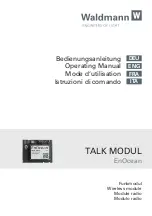
System Configuration
6-54
6
The access point can be configured to periodically scan all radio channels and find
other access points within range. A database of nearby access points is maintained
where any rogue APs can be identified. During a scan, Syslog messages (see
“Enabling System Logging” on page 6-34) are sent for each access point detected.
Rogue access points can be identified by unknown BSSID (MAC address) or SSID
configuration.
• AP Detection – Enables the periodic scanning for other access points.
(Default: Disable)
• AP Scan Interval – Sets the time between each rogue AP scan. (Range: 30 -10080
minutes; Default: 720 minutes)
• AP Scan Duration – Sets the length of time for each rogue AP scan. A long scan
duration time will detect more access points in the area, but causes more disruption
to client access. (Range: 100 -1000 milliseconds; Default: 350 milliseconds)
• Rogue AP Authenticate – Enables or disables RADIUS authentication. Enabling
RADIUS Authentication allows the access point to discover rogue access points.
With RADIUS authentication enabled, the access point checks the MAC address/
Basic Service Set Identifier (BSSID) of each access point that it finds against a
RADIUS server to determine whether the access point is allowed. With RADIUS
authentication disabled, the access point can detect its neighboring access points
only; it cannot identify whether the access points are allowed or are rogues. If you
enable RADIUS authentication, you must configure a RADIUS server for this
access point (see “RADIUS” on page 6-7).
• Scan AP Now – Starts an immediate rogue AP scan on the radio interface.
(Default: Disable)
Note:
While the access point scans a channel for rogue APs, wireless clients will not be
able to connect to the access point. Therefore, avoid frequent scanning or scans
of a long duration unless there is a reason to believe that more intensive scanning
is required to find a rogue AP.
















































